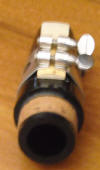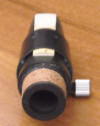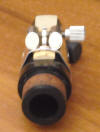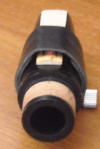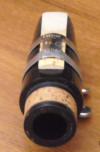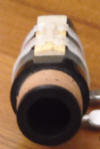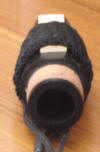| Introduction | The Player | General Thoughts | Clarinet Setup |
| Reeds and Ligatures | Ligature Examples | Mouthpiece and Reeds | Barrel |
| Upper Section/Joint | Toneholes | Lower Section / Joint | Bell |
Since physically studying the clarinet I’ve accumulated alot of notes based on my experiences. I have played tons of mouthpieces and have physically blueprinted them for analysis. I have learned how to reface mouthpieces to make them play a conceived way based on design modifications.
I have also been fortunate enough to own a variety of clarinets and also to repair an even wider variety. In my endeavors I usually don’t only play test and instrument but take it through a fairly lengthy
practice. This has shown, even using the same mouthpiece and reed
combination a variety of observations, such as pressure related and the balance of pressure between upper and lower joints, how barrels affect not only tuning but tonal qualities; and how mouthpieces work, and sometimes don’t work, well with the clarinet itself.
I also believe I am lucky because I try not to have a “fixed” embouchure. By fixed I am talking about the ability of playing to the
mouthpiece that I have and getting the most of it. Most people when they try a mouthpiece use the same reed, the same embouchure, lower lip location on the reed, the same throat, tongue location et all. This is using the same embouchure on other mouthpieces, and as such notable readings have said is that one will sound the same on different equipment. Luckily, as perceived by myself and others, I sound different on different equipment. There are times though, when I do sound the same and I have to work on making myself as
flexible as possible. There are other times when my “ear” is not as
sensitive as other times, whether from being tired or simply I can’t hear a difference at all at that particular time. One must learn to train ones’ ears to hear more minute things and never think that someone else cannot hear something that you cannot.
As you read, I will try to use simple language and convey the information as concisely, though simplistic, as possible. Hopefully, this information will open your eyes as to how instruments vary in design and how those variances can limit or stretch ones playing style; and how each section of the clarinet can greatly affect the
other sections.
The selection of clarinets available today is simply daunting.
In the professional line Buffet has the Tosca, Festival, Vintage, RC Prestige, RC, R13 Prestige, R13 plus their intermediate and student
lines. Selmer-Paris has their Odyssee, Arthea, Saint Louis, Recital, Artys, Signature and Privilege plus Selmer USAs intermediate and student lines. Leblanc up until the Backun and Bliss lines had the Opus II, Pete Fountain, Sonata, Concerto II plus intermediate and students lines. Yamaha has 650, CSG, CSV, and SEV plus their intermediate and student line.
Back in the “good ole days” each manufacturer had basically one professional clarinet. Buffet had the R13, Selmer the Series 9 and 9*, Leblanc was a bit more confusing as they evolved their line with a newer model with sometimes 2 or 3 models available. Selection was a lot simplier back then .. you bought the professional model of Buffet, Selmer Paris or Leblanc and various other small time manufacturers.
But nowadays each player can select an specific instrument that meets their specific style, tonal concepts, etc. But we cannot forget that the player themselves shapes their tone and their relentless
studies are able to provide us the pleasurable and fluid dynamics that we hear through any instrument.
Many players say that each person will sound the same on each instrument. Why is that? Many times it is because that person is “fixed” in the way they play, or they simply do not put enough effort
into hearing the differences. Many professional symphony players can talk your ears off on how they can spend hours and hours doing minute scraps on their reeds trying to find the perfect tone and resistance. What are they hearing that we aren’t ?
My analysis below is simply that of the instrument, the tool that we use to create music. It does not think, it does not create the music that we ourselves create. It is the tool which we use to create what
we and others hear.
And the player is most important part of that tool. The instrument is the tool and the player is the energy for the tool. The players breathe and create the air-flow, whether weak or strong, which creates the dynamics of pianissimo or fortissimo.
And tonal shading is developed from the players techniques. The instrument is the player and the player develops their techniques and abilities over time.
Think of a clarinet as a water hose with water flowing through it. If we make one section of the pipe smaller that creates a backup and increases pressure, ie resistance. Also note, that other variables create resistance, such as the octave vent and how much it protrudes into the clarinet. The clarinet is a long pipe with varying diameters from the mouthpiece all the way down to the bell including the toneholes, register hole including the register vent and thumb hole that all protrude into the bore of the clarinet.
To look at this more closely take a look at your mouthpiece. The tip
height and width is the first restriction to airflow. Of course, the reed
itself is the engine, or generator of sound, which when stimulated creates the basic core tone that we are using to create music. But how that sound is created is highly dependent on the design of the mouthpiece and the entire instrument.
But no matter what, in order for the player to easily move forward and play the instrument, the instrument itself must be properly set up.
When selecting an instrument or mouthpiece many teachers are stuck in the paradigm of “their world”. Such as they were brought up playing Buffets and playing on Vandoren B45s. Of course, we know that Buffets, say R13s, have changed overtime and theoretically one should tell a student to buy a particular serial number clarinet. Otherwise we start adding variances.
And each clarinet can vary alot just based on the setup much less minute manufacturing variances (and other custom modifications)!!
What do I mean by setup. Here is a simple example. Play a C below the staff (xxx-ooo). Carefully listen to the tone. Then let’s say during the setup (or some form of repair) that the bridge key had too thick of cork underneath it.
This setup would basically make the lower joint top ring pad closer to the tonehole. So now while playing a low C slowly push down the top ring pad cup. You will hear the note go flat and stuffy. On the clarinet, key heights are very important for intonation AND tonal quality which is also based on air-flow. Add a leak (where the pad does not completely seal a tonehole and havoc may be created).
In relation to pad height and potential subsequent stuffiness, If a certain player played a more closed tip mouthpiece the tonal
quality may not be affected as much as a player with a larger tipped mouthpiece that likes a higher air flow.
Ever wonder why a repairperson says a clarinet is fine when s/he plays it but it sounds stuffy when you play it? The speed (quantity) of airflow can dictate if an instrument is setup correctly per individual players. Also the person’s ear training may have a large impact on what they hear and what they don’t
Another example. Play a low D (xxo-ooo). Now slowly open the sliver (aka banana key) to play a D#. Do it very slowly and recognize the note as it comes into tune such as this example. Then try this with the Right-Hand Bb trill key. Now compare the two for intonation and tonal quality – basically listen to the variance in sound. Now compare it to first finger of both hands (xoo-xoo).
How do the three vary ?
The important factors to remember here are:
- Key heights affect tonal quality and intonation
-
Airflow can impact tonal quality and impact the
setup design
Reeds are a personal choice. But a little bit of input in that softer reeds are normally thinner sounding and can be buzzy especially after it soaks up moisture. But, keep in mind, amateurs may be learning and start with a soft reed. There is nothing wrong with that scenario as some mouthpieces are designed to correct certain problems.
But as one matures one may realize that a softer reed, though easier to play, sounds thin, can get buzzy and ones’ intonation may be flat
especially in the upper register.
Read this (half way down the linked page) for more information.
Reed quality does vary. Two areas to look at for reeds:
-
Take a look at your reeds with a bright light behind them. Notice the thickness of the veins and compare that to other brand reeds. Also notice the lighter and darker shaded parts and compare that to other strengths and brands of reeds. Compare this to reeds that you like.
-
Compare the butt ends of the reeds. You may notice three variations: symetical cut but may vary in height, offset to the left with the left side thinner than the right side and offset to the right with the right side thinner than the left side.
Concave Mouthpiece Tables
For those that read about a concave mouthpiece table, one must be accutely aware that dependent upon the ligature design, if one tightens a ligature too much the ligature will bend the reed into the concave area.
This will also bend the tip of the reed further away from where it should be from the tip and facing and you will have issues with playing.
Ligatures and Tonal Variance
I am a believer that ligatures can make a difference in ones’ tone. Not necessarily major differences but at least minor differences (including the screw tightness as it can affect how the reed ultimately responds – always make sure screws are lubricated).
But lets look at the basic concept.
Old ligatures were simply a round loop with screws on it. This round loop pushed at the side edges of the reed moreso than pushing the reed up against the mouthpiece.
Later on those loops had indentations for the reed location, and then they evolved into the hundreds of options that we see today.
Several years ago I was playing for a retired pro clarinet player. He loved my playing (playing from his big band books) though he said that my tone had a high pitch squeal to it. This high pitch squeal was not audible to myself until I really listened to the tonal quality
then it was quite prevalent.We had about 8 clarinets there, numerous mouthpieces and numerous reeds. I went through all of them trying to determine how
that high pitch squeal was there but to no avail. Then I recalled that I had used the same ligature on all the tests of various reed, mouthpiece, and clarinet changes. I switched ligatures to a metal band with a floating cradle to better support the reed.
The squeal was GONE.
After that I really worked on improving my ability of hearing variances in tonal qualities based on the ligature and everything else. To my amazement I certainly could hear variances among ligatures.
To quote Jack Brymer from his book “Clarinet”, 1977, pg 70 “If one produces a deep, rich note on any musical instrument, and listens
to it with care over a fairly long period, other higher notes soon begin to make themselves audible in the sound, and to emerge into the consciousness, most of the pleasantly related to harmonically but a few of them slightly dissonant.”
That quote rang true in my learnings with the above ligature example.
In short, metal ligatures that are based on a loop and fully cradled the reed (I only tested a few) tended to have slightly higher harmonics to them than the non-metal ligatures. But most of the fabric/rubber ones that fully cradled the reed tended to slightly darken the
harmonics by comparison.
My favorite is a BG revelation ligature which is fabric with a metal insert to push the reed up to the mouthpiece in a cradle. The sides of the ligature do not touch the reed. My other favorites are: Vandoren Klassik (a 100% string ligature, Vandoren Masters (metal), Vandoren
Optima with the horizontal ridges (note: the 4 pinned plate must not be over tightened otherwise the pins dig into the reed and create a full platform);
Rovner dark (though this tends to deaden the tone a bit as it cradles the entire width of the reed).
Players should not worry about ligatures until they mature to a certain level. Reeds vary greatly too and one should listen to their teacher for direction here until they are mature enough to move forward with their own experiments.
In Summary
-
Only more mature players may audibly hear the minute differences.
-
The ligature design of how it cradles the reeds affects the tonal quality
-
The tightness of the screws affects the response and tonal quality
-
Always lubricate the screw(s) – this eases it’s installation
Ligature Pressure Points (Reed support)
Pictures with arrows shows the pressure points from the ligature to the reed. A reed shaped piece of foam with square lines on
the back end was used to identify which parts of the reed got compression from which direction then noted. Pictures below show a cane reed installed.
The mouthpiece is the first major variable one comes across when selecting an instrument. Sometimes you buy a clarinet and you play what is in the case. But as one progresses they start searching for a different sound, or a teacher recommends a particular brand and model of mouthpiece.
What exactly is the difference between mouthpieces.
Click here are some numbers just to peruse
But what do all those numbers mean and how do they relate to how a mouthpiece actually plays ?
Let us first take a look at two factors that one should be able to see without measuring tools.
Second, take a close look at the tip of the mouthpiece. At the very tip it is flat but right after that
it starts going down to the throat of the mouthpiece. Some mouthpieces have what is called a “roll over” baffle. The baffle, for this explanation is the part right behind the tip. At first this is hard to see until you have a mouthpiece with a roll-over baffle and one without. But, in general the mouthpiece with the roll-over baffle will provide a faster response and brighter tone than the one without a roll-over baffle. The non-baffle mouthpiece may sound more dull sounding (or darker depending upon design) and less
focused.
Just below the tip the design of the baffle down to the throat are very important in the intonation and tonal quality of the instrument (assuming the mouthpiece is well matched to the instrument).
If one were to take many completely 100% perfect copies of each other and experiment one would learn that as one modifies the baffle going down one would get a tuning modification going down the instrument. The mathematical model of this is too complex to review in this summary but if broken down into three quadrants the upper quadrant would affect the intonation of all left hand notes and the high register sound production. The 2nd quadrant is related to the intonation of the lower and left hand low register. The third quadrant is directly related to the intonation of the low register.
The mouthpiece bore itself can have effects on the throat tones – a smaller diameter and the sharper the throat tones; a larger diameter
and the flatter. But it also regulates the fullness of the higher
register. Experimenting with mouthpieces really made me feel like making mouthpieces, but the complexity and fine-tuning really is for a more a professional clarinet player to design, blueprint and play test. There are many more aspects of the mouthpiece which affect the way it plays.
Overall, all the aspects of the mouthpiece make a difference in the way it sounds to the ears, and responds to the player. The baffle
from tip to throat, the shape of the throat, tip opening, type and length of rail curve, thickness of rails, shape of window box going down to baffle, shape (cylindrical or conical) of bore in addition to the type of material.
But the reed which is attached to the mouthpiece is the generator. The reed which is stimulated and vibrates creates a synchronous
sine wave (a single fundamental with no harmonics also known as a pure sound), unsynchronous saw-tooth type (contains all types of harmonics also known as a rich sound); and a square wave which only contains odd-number harmonics (more on this later).
This basic idea of the “generator” is quite simple. This is air-dynamics, or simply put the air that the player blows into the instrument using the reed that vibrates and thus excites the air column inside the clarinet. A player’s air column, a nice steady stream which as we know produces a nice constant tone, is deflected over the surface of the reed and pushes it shut. The reed itself, due to it’s strength like a diving board, returns to the open position until the air stream pushes it shut again. This is the process that creates the waves of air into the clarinet.
The strength of the reed helps determine that major type of waves that are created. A full ranges of harmonics and overtones is
possible when it opens and shuts very rapidly. When acting more slowly the harmonics are much more limited. The player uses a damper, their lower lip to increase or decrease the spring tension of the reed to generate the various sound one is after.
Faster reed vibrating cycles generate brighter sounds, and conversely slower cycles generate more mellow sounds. This is the basis of
tone production and tone variation and thus the method the air-stream is influenced upon the reed becomes important. The shape of the reed is also important, such as the difference between a Vandoren and Mitchell Laurie.
But let’s get back to the mouthpiece. Now that the reed is generating harmonics these harmonics are being sent 90 degrees from a straight reed. Basically into ones lower mouth and into the mouthpiece. The roof of the mouthpiece, the slanted part opposite the reed reflects these harmonic waves which bounce back further along the reed, and back to the mouthpiece until it has a good angle and bounces down the bore of the mouthpiece and further along.
This is where the inner design of the mouthpiece helps define and shape these harmonics. Thus any slight variation can affect the way a mouthpiece shapes the tone.
Coincidentally, the air pressure from the player, countered by the back-pressure from the instrument tends to lift the reed away from the mouthpiece. Thus the role of the ligature. A ligature made from a flexible material, such as the Vandoren Klassik, will allow the reed slightly more flexibility, thus a longer reed, thus slower vibrations, thus more mellow sounds. One that clamps more allows less reed flexibility, thus a shorter reed, thus faster vibrations, thus brighter sounds. Of course, this is a very small impact. Very few will be able to audibly hear the differences.
For those of you really interested in a blueprinted mouthpiece, here is a rejected Boosey & Hawkes mouthpiece design. This shows the complexity of
how a manufacturer designs a mouthpiece.
As has been stated many times on many BBoards/Forums, the
further up the instrument you go the more important it is for sound production, which starts first with the Player.
The barrel is an interesting piece of the clarinet. Buffet, at one time in the 1920s designed a clarinet as one-piece with the barrel, upper and lower joint. The only add-ons were the bell and
mouthpiece. This certainly is a good idea of matching the barrel with the upper and lower joint. We just hope that the player is as good as the instrument tester that adjusts the instrument. The main problem with this design is finding a good, long piece of African Blackwood (aka M’Pingo, aka by an industry trade name of Grenadilla [not to be confused with
Grenadillo])
In readings it has been stated that the optimum length of a
barrel for intonation and sound is 66mm. This, I assume is for a
cylindrical barrel on Buffet R13s. But with the advent of tapered bores the length of the “best” barrel has dropped several millimeters and the use of a Moennig or Chadash style barrel the optimum length would be approximately 65mm
In most writings and readings it has been stated that the barrel cannot be interchanged with different manufacturers or even different models of each manufacturer. And yet, there are barrel makers out there selling a generic sized bore for all brands of clarinets.
I also have not had the chance to experiment with “copies”.
For instance, will a Yamaha CS (old model) which was modeled after the Buffet R13 have an interchangeable barrel (for tonally and intonation) with an R13, or vice versa ?
Through experimentation, with cylindrical examples, a barrel bore larger than that of the clarinet bore will cause the lower register to go flat and sharpen upper tonehole notes of the upper register. Conversely, a smaller bore barrel than the clarinet will sharpen the lower register and flatten certain the upper register notes. (to understand this more read the section about Sound Waves)
Moennig and Chadash have created barrels that are slightly
shorter but contain a reverse conical bore (such as in German clarinets). For the general Buffet R13 which these were designed for (not cylindrical bores) they actual improved tuning in certain cases and improved the use of larger bore mouthpieces.
Yamaha CSG
A quick note on short barrel instruments like the Yamaha CSG.
Many players, when playing sharp will pull out the barrel. This in effect lower the overall pitch of the clarinet. But by pulling the barrel out it creates an air pocket between the barrel and upper joint. This air pocket will have an effect on the closet toneholes, the throat toneholes, and thus those notes are now disproportionately flat.
Clarinets with a longer body, such as the Yamaha CSG, uses a longer body and shorter barrel (56.4mm versus normal 66mm barrels) effectively moving that air pocket further up and thus further away from the throat tone holes. This effectively allows the instrument to be tuned more proportionately including the throat notes.
Tuning rings and various length barrels also effectively allows the player to tune the clarinet more proportionately.
There are three type of bores for the upper joints of clarinets.
- (1) Cylindrical, where the bore is the same size at the top and bottom of the joint. (example: early Selmer CT)
- (2) Reverse cone where the top of the joint has a larger bore than the bottom of the joint (example: Buffet R13); and
- (3) Cone where the top of the joint is a smaller bore than the bottom of the joint (example: Leblanc L7)
The (3) “cone” may take many people by surprise. But by measuring some clarinets it became obvious with the lower barrel bore equaling the top of the upper joint bore and the upper socket bore of the lower joint equaling the lower bore of the upper joint that the measurements were correct. I found most of these examples on Leblanc clarinets.
(2) Reverse Cone
Buffet made famous the polycylindrical bore, which in essence is a 3 step bore that decreased in size from the joints top to the bottom of the joint. Before the advent of the R13 in 1955 Buffet used the “Master Bore” which was a 2 step deux-cylindrical bore.
The Reverse cone can have a couple designs which affect the
clarinet tonally.
- The “stepped” reverse cone which may (as an example) make a
more compact, focused and powerful tone while still maintaining a darker sound (all other variables being equal). - A more evenly tapered reverse cone which can create a more flexible, yet powerful playing clarinet with a more “sweet” tonal quality (all other variables being equal).
(1) The cylindrical bore is found on many older clarinets, and of course is the easiest to create.
- Small cylindrical bore clarinets generally offer a compact tonal quality with ease of playability (example: vintage Leblanc Symphonie II)
- Larger cylindrical bore clarinets (example: early Selmer Centered Tones – later models were a reverse cone like the Series 9) generally allows a player to create a much larger presence and dynamics with more ease.
(3) The conical bore
- The conical bore is a newer anomaly and is taking further time to research and test. But in general it offers a much more free blowing characteristics as pressure is generally reduced immediately at the upper joint.
But the bore itself is not much without talking about the
tonehole design.
The placement of the tonehole is upmost important in creating
a correct intonation. And the overall bore is dependent upon the width and height of the toneholes.
But the design of the tonehole itself can impact many factors. The location can be tweaked too to provide a slightly different timbre, such as a Bb clarinet with a timbre similar to an A clarinet can be created by slightly modifying the location, width and height of the toneholes. In short, these are the varying designs of toneholes:
[a] Size of the tonehole – for simplicity, small, medium or large
[b] undercutting of the tonehole – where the bottom of the
tonehole’s width is a larger width than the middle
[c] overcutting of the tonehole – where the top of the
tonehole is wider than the midde.
A manufacturer may employ both undercutting and overcutting
and may employ various aggressiveness in overcutting or undercutting such as having a larger undercut than the overcut.
Before we review detailed acoustical impacts of design let us
take an example and use some theoretical modeling on it.
The base instrument we will talk about is the Buffet R13. We know the approximate bore dimensions and tonehole design of the R13.
If we first increase the bore size we will get a slightly darker sounding instrument (all else being equal).
But by increasing the bore size we now have the toneholes in the wrong location in relation to overall volume (bore + toneholes). Let’s say we don’t move the toneholes but make the toneholes smaller and we can theoretically bring the instrument relatively back in tune as the volume is brought down. But by making the toneholes smaller we now have an R13 that is slightly more resistant, but a more focused sound and improved projection. It can also have a more even response in the sense the increase air support will give a wider range of dynamics (ie, blow harder) slightly more easier than the base example bored R13. But realistically, the toneholes would move.
Now with the larger bore we can relocate the toneholes and provide larger toneholes. This will provide a much more free blowing R13 with a larger volume of sound being more easily achieved.
If we look back in history at large bore clarinets the Selmer Centered Tone comes forward. The CT was a big bore (15mm) and large tone hole instrument. You can achieve extremely large dynamics (with the proper mouthpiece) if one desires too. A perfect instrument for standing in front of saxes, trombones and trumpets and playing away and being heard. Keep in mind, that in the 1950s Selmer only had the Centered Tone as their professional clarinet.
Undercutting and overcutting allows smaller toneholes to have some of the attributes of the larger toneholes but without having the larger size. This make for ease of covering the toneholes.
A quick note on the register vent. Many makers will move this vent from
time to time to change the characteristics. For instance. Visual
inspection of a late Selmer Centered Tone and an Early Selmer Series 9 (tone
hold diameters were the same), entry and exit bore of the upper joint were the
same, etc; but the location of the register vent was a higher position and
smaller diameter register vent. In general, when one places the register
tube higher you generally need to have a smaller diameter vent tube. This
allows for proper tuning of throat Bb but changes the throat Bb tone. But
this location change also affects the upper register left hand notes by
subsequently flattening them. It also generally makes the upper register
right hand notes more resistant.
The R13 went through a change from the 1950-60s design by a relocation of the register vent. These changes, then slight bore or tonehole changes to
accommodate other nuances puts the manufacturers in the ever non-ending evolution of trying to design the perfect clarinet.
More information coming on Barrels, Upper Section/Joint, Lower
Section/Joint and Bells
Come back for more information as it is added.
A QUICK NOTE ON CLARINET EVOLUTION
Clarinets have evolved from simple cylindrical shapes to complex bore shapes. But why one may ask. The answer is fairly simple, though the solution is very complex.
The clarinet is based on 12ths that you get on other instruments. The design of the clarinets’ twelves really brings to light older instruments problems in relation to what seems to be misplaced tone holes, especially the speaker key.
Over the years, there have been corrections by reshaping the bore at various points, tonehole sizes, speaker key placement and shape, height and bore penetration. Basically, using various length tapers with
different gradients; altering bell design such as the flare and overall weight; and by the mild bore taper increase from mid (or higher) part of the clarinet to the bell all affect the twelves in many ways. As you also read, even the mouthpiece has been experimented upon. As mentioned in the tonehole section the undercutting also can be used, but undercutting should be carefully added (if it doesn’t already have it) as over use can diffuse and decrease resonance.
RESEARCH MATERIAL
ON-LINE RESOURCES
http://test.woodwind.org/clarinet/BBoard/list.html?f=1
The BEST clarinet BBoard on the net. Professional players, manufacturers and students alike converse on this BBoard.
http://www.Woodwindforum.com – a new woodwind website in which I’m a Content Expert for Clarinets and Saxophones. You can catch some of the results of my experiments here.
http://www.SaxOnTheWeb.net – another online website primarily for
saxophones.
http://www.phys.unsw.edu.au/music/clarinet/
PRINTED RESOURCES
The Saxophone Is My Voice book by Ernest Ferron – a great book on saxophone that I’ve read many times. I’m sure there’s many relevant items on clarinet playing too.
The Clarinet Revealed by Ernest Ferron – a fantastic book for one that wants to learn more about the acoustics of a clarinet
Clarinet Acoustics by O. Lee Gibson – another fantastic book for learning about clarinet acoustics. I took his testing example and used on a wider variety of clarinets and mouthpieces.
Clarinet by Jack Brymer – my first book about the clarinet that I purchased back in 1978. A great book to start out with even though it is 260ish pages long. This was my first delve into the accoustical characteristics of clarinets.
The Clarinet and Clarinet Playing by David Pino
PRINTED INSTRUMENT REPAIR RESOURCES
A Clarinetists Notebook Vol 1 by Robert Scmidt – a great repair book about Hans Moennig’s techniques
Band Instrument Repairing Manual by Erick Brand – obtained from Ferree’s Tools. A great book on Mouthpiece refacing and also, many repair books review how to properly fix intonation.
A Guide to Repairing Woodwinds by Ronald Saska
PEOPLE RESOURCES
Gary Ferree of Ferrees tools in Kalamazoo. He passed away in early 2009 but I learned a lot from him since 1998. He was an engineer for Mr. Herbert Couf in the earlier years too.
Edward Zentera – a neighbor, friend and great saxophone mouthpiece refacer whom we’ve spent alot of time alking about mouthpieces and play testing mouthpieces, play testing saxophones too !!
INSTRUMENT RESOURCES
And to the many mostly Selmer Paris clarinet mouthpieces that I hacked to understand their complexities and the three mule clarinets that are always by my side; a Buffet R13, Selmer Centered Tone and a Leblanc LL which I did many mouthpiece tests on the three instruments and documented general mouthpiece tests here.
Like many musicians and clarinet fanatics, I also own other clarinets. At this time it includes a 1950 Buffet Full-boehm, 1974 Leblanc LL
and a 1930s Selmer to name a few.




